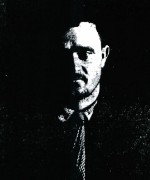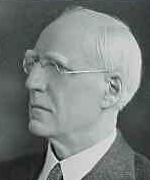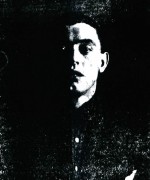Four Capital Murder Trials Since the Last Execution in 1905
by Justice Dale V. Sandstrom
Although the hanging of John Rooney in 1905 was the last state-sanctioned execution in North Dakota, the Alfonso Rodriguez case in federal court in Fargo is not the first capital trial in the state since then. At least three other men were tried in the state for capital murder after Rooney and before Rodriguez. All three were found guilty of murder. Two were sentenced to hang, but neither did. The last man sentenced to death by hanging was spared in 1915 when the North Dakota legislature retroactively abolished the death penalty for most cases.
The Murders
Shortly before 8 o'clock on the morning of October 9, 1914, farmer G.E. Cooper found two severely beaten, apparently lifeless men alongside the Great Northern Railroad tracks two miles southeast of Lansford, in Bottineau County. Their skulls had been smashed, apparently with two bloody rocks found nearby. One of the men was dead. The other was near death. Their clothing had been torn from their bodies and "even their shoes and socks removed."(1)
A "cheap watch" was found that had been broken in the assault and stopped at 10:05, by which officials marked the time of the assault the night before.(2)
The still-living victim, identified from papers at the scene and by two local residents as J.N. Karst of Breckenridge, Minnesota, was taken to the local hospital with no hope for survival.(3)
Left at the scene was a $47 draft from one of the local residents, payable to Karst and drawn on the Security State Bank of Maxbass. The local residents also reported Karst's gold watch was missing.(4)
Karst was reported to have been divorced from his wife "a year or two ago" and to have been traveling about the country working at odd jobs even though he was said to own a half section of land near Breckenridge.(5)
The Lansford Journal lamented the unjustified bad name given to the community by "the undesirable class of men that come here during the harvest season."(6)
Bottineau County Sheriff L.P. Sandstrom(7) was quickly on the case. Although the newspapers do not detail his methods, he was soon at the scene and on the trail of two suspects, identified as the likely perpetrators, who tried to sell a gold watch to a Standard Oil agent in the Deering-Granville area.(8)
Karst, "terribly injured," lingered two days before dying. The second victim was identified as Albert Sisel, whose father was a resident of Calgary, Alberta.(9)
The Arrests
The suspected perpetrators were arrested in Fargo on October 12—four days later. The Lansford Journal and The Bottineau Courant differed as to who made the actual arrests. The Courant credited Sheriff Sandstrom with the arrests,(10) while the Journal, in a more detailed article, credited a Lansford man, Emery F. Johnson, with the arrests.(11) The Journal felt it important that a Lansford man be credited with bringing the criminals to justice:
Lansford has received some unsavory reputation through no fault of the residents of this city; and it is hoped that the people of the state at large will remember that it was a Lansford man that made it possible to avenge the terrible crime, and therefore, forget that the crime was committed at our door. It was the work of transients over whom the people of the city had no control.(12)
There was no dispute that it was Sheriff Sandstrom who elicited a confession to murder from Joe Milo, which was repeated to State's Attorney W.H. Adams and taken down by a stenographer and signed before a notary public.(13)
 |
| Joe Milo |
Joe Milo admitted the murder-robbery, confessing to killing Karst. He told how the four men had worked together on a threshing rig near Hurd. After cashing their paychecks at the First State Bank of Hurd, they had taken the Soo freight train to Lansford and then headed toward Forfar. Milo said he and Miller had then set upon their victims, felling them with rocks and robbing them. Milo said that the other man arrested, John Miller, had killed the other victim, Sisel. Milo said he took $55 and some cents from Karst, as well as the watch he eventually sold for two dollars. Miller strongly denied having killed anyone, claiming Milo had killed both men and had threatened to kill him if he said anything.(14)
The Trials
Justice moved swiftly. The cases led the November term of court at Bottineau, with the defendants being tried separately.(15)
A jury was seated and quickly found Milo guilty of murder and recommended a sentence of death by hanging.(16) The Bottineau Courant reported:
Milo showed little or no interest when the verdict was read by the jury foreman. He had expected a life sentence in view of his confession, but showed little concern and a half hour after being taken back to his cell, was sound asleep.(17)
The trial of Miller was more difficult. Jury selection took two days because almost every potential juror called was opposed to the death penalty. After a jury was selected, the trial went forward. Miller took the stand in his own defense, testifying that Milo had murdered both men. The jury found Miller guilty and recommended life imprisonment as his sentence.(18)
 |
| District Judge A.G. Burr |
On December 5, 1914, District Judge A.G. Burr—later a justice of the North Dakota Supreme Court—sentenced both men as the jury recommended: Milo to death by hanging at the State Penitentiary on Friday, the 13th of August, 1915; Miller to life imprisonment.(19) Under North Dakota law, Burr had been required to follow the jury recommendations unless in his "opinion . . . the punishment imposed [was] greater than under the circumstances of the case ought to be inflicted."(20) Milo seemed unaffected by his death sentence. Miller sobbed uncontrollably, protesting his innocence.(21)
Milo did become concerned that after execution his body would go to the University of North Dakota for dissection. The Lansford Journal reported that Milo had set out a donation box at the jail to raise enough money so that he could be buried rather than dissected. On December 11, 1914, The Journal reported that it looked as though Milo would raise enough money for burial.
By New Year's Day of 1915, both Milo and Miller were in the State Penitentiary at Bismarck. The Bottineau Courant reported that Joe Milo was the "alias" of Gura Makarun and that he was being held in solitary confinement under a 24-hour death watch in an otherwise empty tier of the penitentiary.
 |
| John Miller |
A screen kept him from seeing or hearing what else was going on in the prison. The Courant observed that Milo was "a rather attractive person" who was "said to have the best set of teeth in the penitentiary."(22)
John Miller, The Courant reported, was the "alias" of Janke Kuzata, and he was about 23 years old and had "a wife and two children in the old country." Miller was reported to be working at the prison twine factory and to be a "model prisoner."(23)
An Earlier Death Sentence
The Lansford Journal and The Bottineau Courant, in their coverage of the Lansford murders, reported there had been one death sentence handed down since John Rooney had been hanged in 1905. The Courant noted, "It is seven years since a jury in North Dakota has meted out the death sentence, and more than ten years since such a sentence has been carried out."(24) The Journal reported:
Little Rising, the Indian charged with the murder of Frank Siedel, postmaster at Sombre, this county, and his niece, was the last man to be sentenced to death by hanging. He gained a stay of execution only five hours before the time set to hang.(25)
Legislative Reprieve
Sheriff L.P. Sandstrom, credited with quickly solving the double murder, had not sought reelection to that office. Instead, he ran for and was overwhelmingly elected to the State Senate, with 1456 votes compared to his opponent L.L. Stair's 839.(26)
Historian Frank Vyzralek has written that by 1915, a "growing sense of pacifism" resulted in juries, "time after time," recommending life imprisonment instead of death as the penalty for murder.(27)
In January 1915, state Representative L.N. Torson from Rugby, in Pierce County, which adjoins Bottineau County, introduced House Bill No. 33 to abolish the death penalty. After a number of revisions, including amendments making it retroactive and adding an "emergency clause" to make it effective on approval rather than the usual date of July 1, the bill cleared the House.
On February 5, 1915, The Lansford Journal reported that the "bill as amended, if passed and approved, would result in Joe Milo being saved from death by hanging."(28)
In the Senate the Bill itself recovered from apparent death and was amended to provide the possibility of death by hanging for killing a prison guard—although the broader language covered anyone convicted of a first degree murder while under a life sentence for first degree murder.
On March 12, 1915, The Bottineau Courant headlined "Milo is not to Hang" in reporting on the approval of the Torson bill. The Courant reported, "Senator McFadden made a plea in the senate for passage of the act with the emergency contending that the state should not take the life of Milo." (29)
The Courant said that Senator L.P. Sandstrom, the former sheriff, was one of only twelve senators and two representatives to vote against the final bill.(30)
The 1973 legislature, as part of North Dakota's new criminal code, abolished the death penalty for all state crimes, effective July 1, 1975.
Sept. 7, 2006
Footnotes:
1. Two Men Robbed and One is Dead, The Lansford Journal, October 9, 1914, at 1; Double Murder at Lansford, The Bottineau Courant, October 16, 1914, at 1.
2. Id.
3. Id.
4. Id.
5. Id.
6. Id.
7. No known relation to the writer.
8. Two Men Robbed and One is Dead, supra note 1.
9. The Murdered Men Fully Identified, The Lansford Journal, October 16, 1914, at 1. The Bottineau Courant referred to the second victim as "H.M. Seisel." See, e.g., John Miller, Who is Serving a Life Sentence for Murder, The Bottineau Courant, January 1, 1915, at 1.
10. Double Murder at Lansford, The Bottineau Courant, October 16, 1914, at 1.
11. Johnson Captures Murderers Easily, The Lansford Journal, October 16, 1914, at 1.
12. The Murdered Men Fully Identified, supra note 9.
13. Joe Milo Makes Written Confession of the Murder of J.N. Karst, The Lansford Journal, October 23, 1914, at 1.
14. Id.
15. Murderers Arraigned, The Lansford Journal, October 30, 1914, at 1; District Court, The Lansford Journal, November 20, 1914, at 1; Jury Wants Milo Hung, The Lansford Journal, November 27, 1914, at 1; Penitentiary for Sisel's Murderer, The Lansford Journal, December 4, 1914, at 1.
16. Jury Wants Milo Hung, supra note 15.
17. Joe Milo Plead Guilty, The Bottineau Courant, November 27, 1914, at 1.
18. Penitentiary for Sisel's Murderer, supra note 15.
19. Milo and Miller Sentenced by Burr, The Lansford Journal, December 11, 1914, at 1.
20. Compiled Laws of 1913, Penal Code § 9478 and Code of Criminal Procedure § 10893.
21. Milo and Miller Sentenced by Burr, supra note 19.
22. Joe Milo, Who Will Hang on Friday, August 13, 1915, The Bottineau Courant, January 1, 1915, at 1.
23. John Miller, Who is Serving a Life Sentence for Murder, The Bottineau Courant, January 1, 1915, at 1.
24. Joe Milo Plead Guilty, supra note 17.
25. Penitentiary for Sisel's Murderer, supra note 15.
26. Republicans Win All State Offices, The Lansford Journal, November 6, 1914, at 1.
27. Frank Vyzralek, Murder and death by hanging: Capital crimes and criminals executed in northern Dakota Territory and North Dakota, 1885-1905 (October 19, 2000).
28. Joe Milo May Not Be Hung, The Lansford Journal, February 5, 1915, at 1.
29. Milo is not to Hang, The Bottineau Courant, March 12, 1915, at 1.
30. Id.

